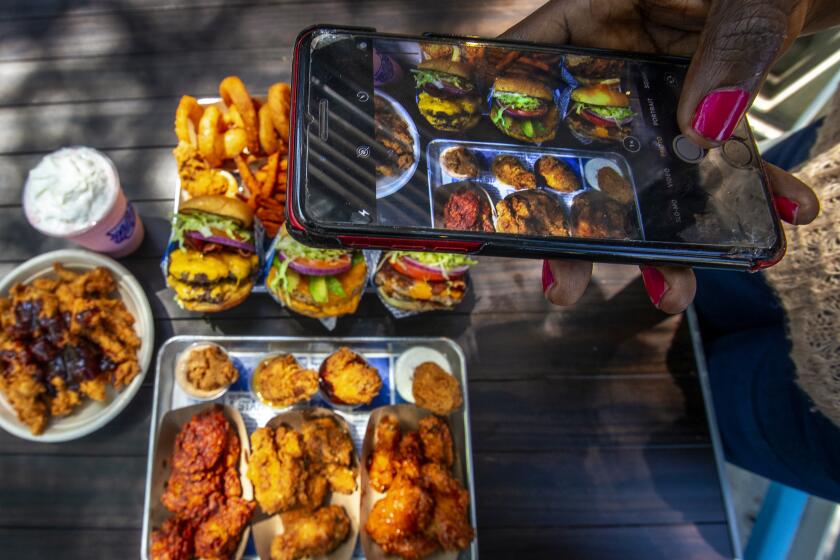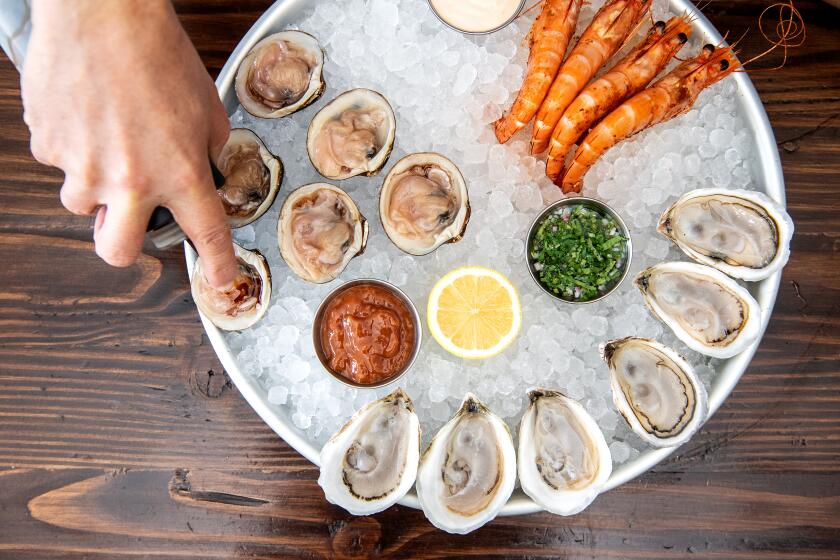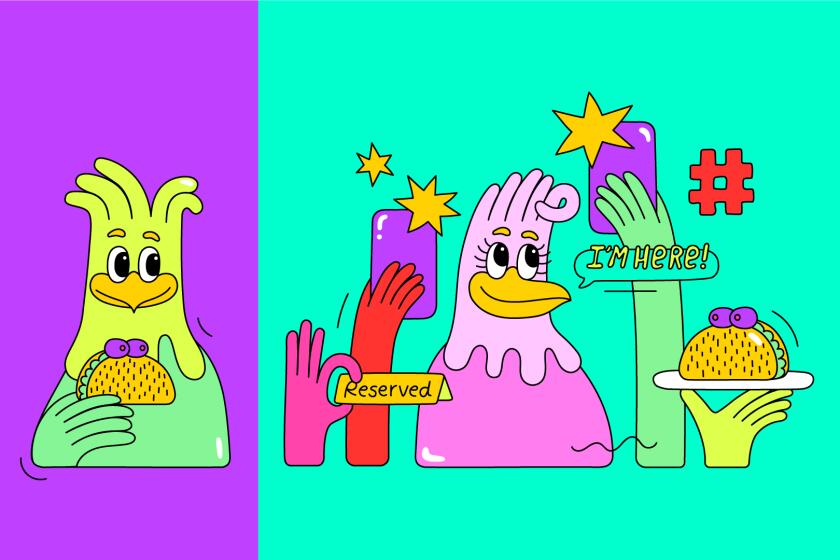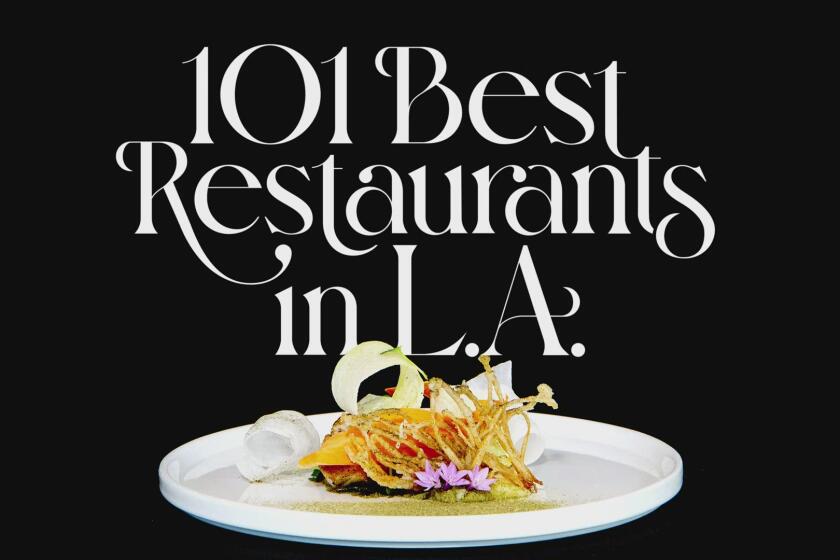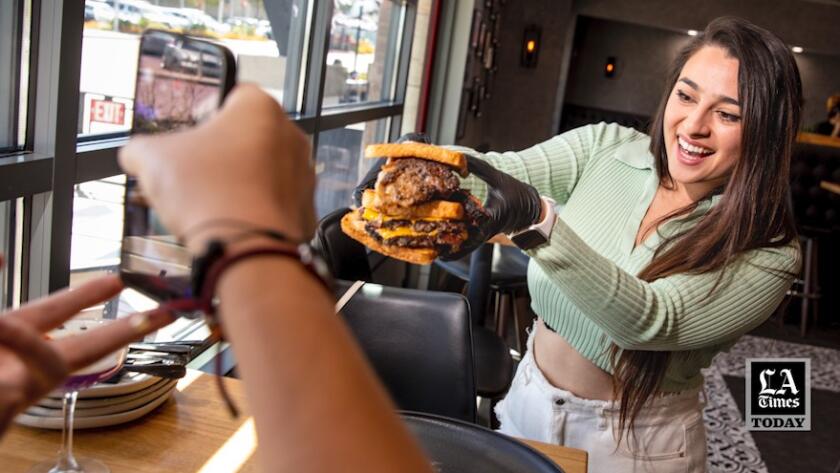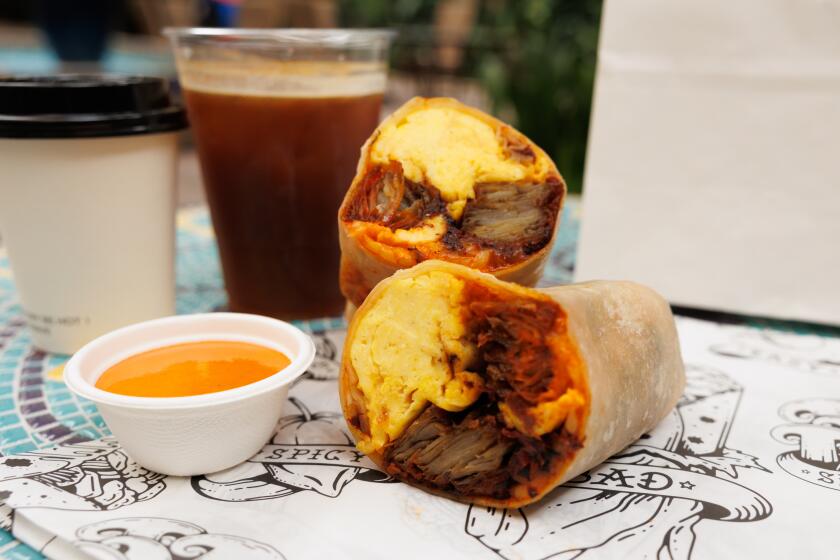
- Share via
In more than 20 years at his family’s restaurant, Joel Gonzalez had never seen anything like it. Around 6 p.m. on March 25, 2021, he looked up to find a line stretching out the door of Mariscos Corona, the Van Nuys restaurant he runs with his sister. For the next two hours, the siblings did their best to manage the surge of customers eagerly requesting the restaurant’s signature dishes: aguachile-stuffed avocados and surf-and-turf burritos.
“Oh my God, we had such a rush” until closing time, Gonzalez says. “We had never seen a line out the door like that before.”
The next day, a Friday, there was another line, and the onslaught of customers continued through the weekend. The restaurant’s Instagram account gained 5,000 followers. Gonzalez ran out of avocados; eventually, his refrigerator was empty. He couldn’t open on Monday.
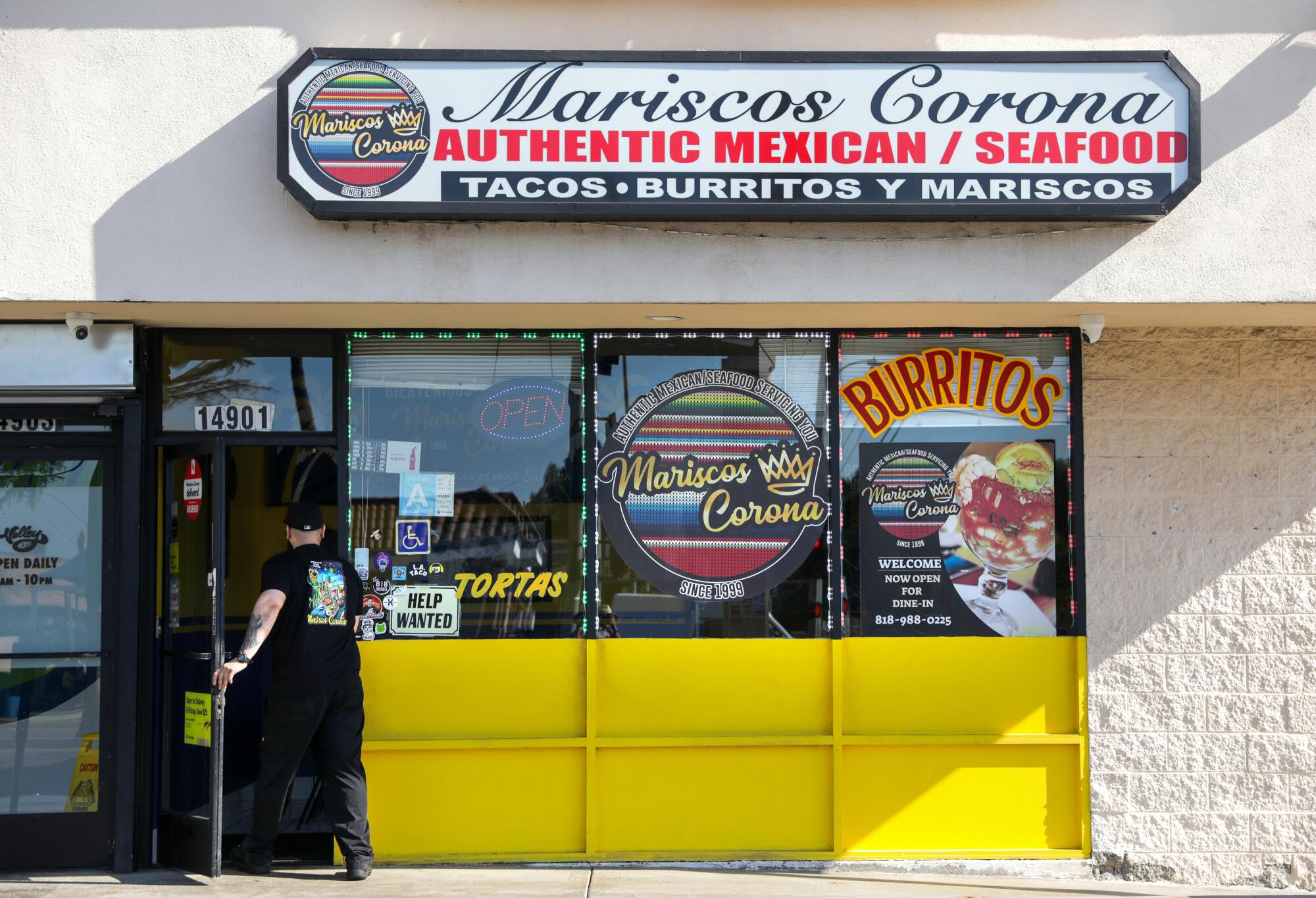
What Gonzalez didn’t know, when the crush started, was that Ashley Rodriguez, 29, a food influencer also known as @firstdateguide on her social channels, had posted a 42-second TikTok video featuring his soon-to-be-in-demand dishes earlier in the day.
Viewers got a glimpse of avocados overflowing with citrus-drenched seafood and a giant grilled burrito stuffed with shrimp, carne asada and French fries. At one point, Rodriguez poured an entire cup of red salsa onto the burrito, took a big bite and nodded enthusiastically — just like a trusted friend who wants you to know about a new restaurant you have to try.
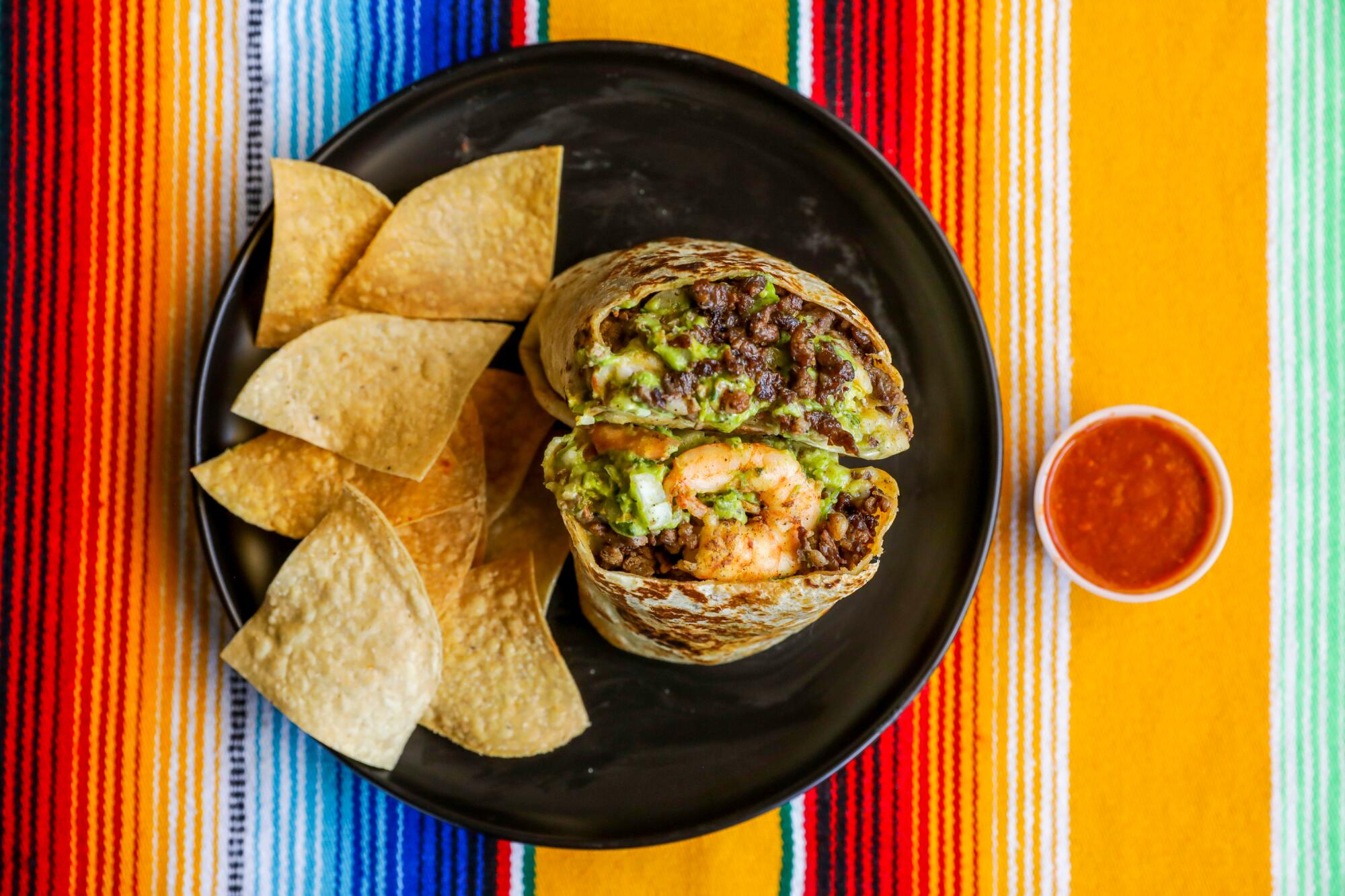
The video attracted more than 200,000 views overnight and hit 1 million views in a week.
Eventually, “one of the customers that [first] day told me that he had seen our restaurant on @firstdateguide,” Gonzalez says. “That’s when we put it together.”
This is the food influencer effect — or, what it can be. If the right influencer posts a video of your food and it hits, it can lead to a larger social following and a noticeable increase in revenue.
It’s a phenomenon that’s causing a paradigm shift in the restaurant world, transferring the power of influence from traditional media to anyone with a cellphone and a love for food. And these days, sometimes seemingly spontaneous expressions of restaurant fandom are actually well-planned, calculated business transactions.
That’s exactly what happened at Mariscos Corona. Gonzalez had hired Rodriguez to promote his restaurant — he just didn’t know when her video would be posted.
A few weeks before the surge, Gonzalez had DM’d Rodriguez on Instagram, inviting her to try his food. Rodriguez explained that her rates range from $1,500 to upwards of $10,000 — depending on her following and the platform where a business is looking to be featured. Gonzalez agreed to pay Rodriguez $1,500 for one video that she posted to TikTok and, later, Instagram. Gonzalez says he spent an additional $40 for her food.
“If I could tell any other restaurant owner — it was worth it,” he says.
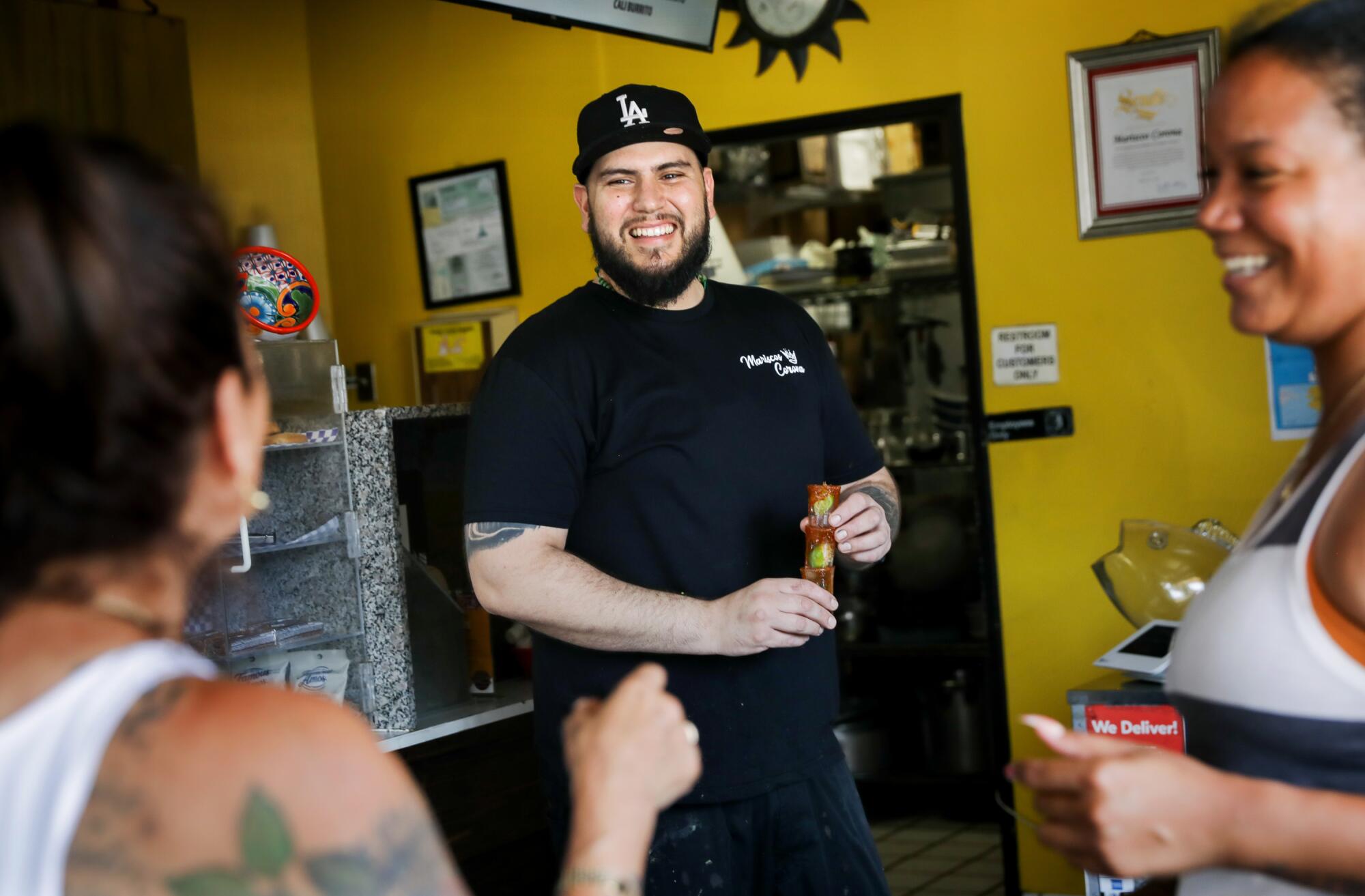
Food influencers come in many varieties: There are the home cooks who post how-to videos of dishes, mukbangers who livestream themselves eating, newbies looking for free food, marketing professionals with restaurant clients, gourmands who review food in their cars, and food obsessives who just like to share what they’re eating. Some influencers have agents and make a living through brand and restaurant deals. Others do it for the free products and perks. Most of the restaurants they work with are not the kinds of places you’ll find on a critic’s best-restaurants lists.
Two newspaper restaurant critics take some cues from food influencers but stick with traditional rules — like no free meals.
Rodriguez, along with influencers Paul Castro, 28, and Hugh Harper, 39, founded the L.A. branch of a Las Vegas-based marketing company called JMPForce. They work with about 20 local restaurants, handling their social channels and creating content. While the three regularly post non-work-related photos and videos, Rodriguez estimates that about 60% of the restaurants featured on her channels are clients.
If it were up to Rodriguez and the rest of the JMPForce crew, they wouldn’t be labeled influencers.
“I always say ‘food blogger’ because it makes me feel better than ‘food influencer,’” Rodriguez says, seated at a table at Craft by Smoke and Fire, a restaurant client in Arcadia. She was there to film content with Castro, who is also her boyfriend.
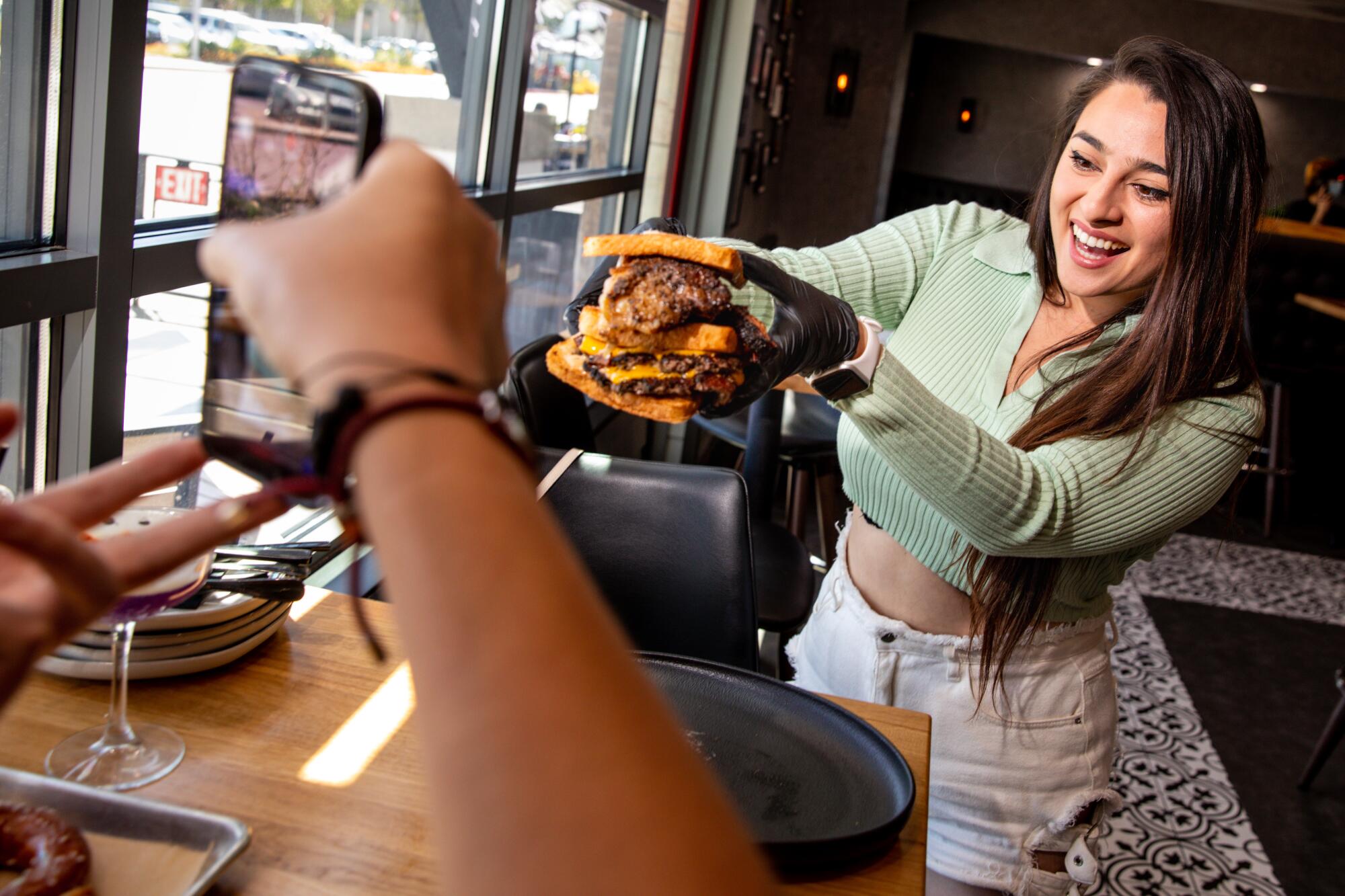
“There are too many influencers trying to take advantage, so I don’t want to be intertwined with them,” Castro adds.
Earlier this year, an incident involving a Los Angeles food influencer and Corner 17, a Chinese restaurant in St. Louis, blew up online when owner Xin Wei posted screenshots of the interaction on Instagram. The influencer requested $100 to pay for food he wanted to feature in a video, but the restaurant declined.
Antonio Malik, known online as @antonio_eats_la, visited anyway and posted an Instagram story review to his hundreds of thousands of followers. He complimented the service but had some not-so-nice things to say about the food: “Worst dumplings ever!”
Wei responded in an Instagram post: “An intentionally bad write-up from a large-following influencer because of our refusal to accept their collaboration is unprofessional and such a hostile manner can simply ruin their businesses. I want to step up because we felt threatened by this media influencer.”
The incident raised questions around the ethics of “collaborations,” the term used for an exchange of free food or other goods for social media content. Rodriguez and Castro say that requesting free food from restaurants that are not actively seeking social promotion is common among influencers who are just starting out.

Subscribers get exclusive access to this story
We’re offering L.A. Times subscribers special access to our best journalism. Thank you for your support.
Explore more Subscriber Exclusive content.
Pim Techamuanvivit, the chef and owner of Nari and Kin Khao in San Francisco (temporarily closed), says she receives at least a couple of Instagram messages a week from influencers asking for free meals.
“They sort of code it and say, ‘We’d like to collaborate,’ but it doesn’t mean we’re going to collaborate on anything,” she says. “It means, ‘I don’t want to pay for my food.’‘”
The Federal Trade Commission has guidelines in place for influencers, though the process is still very much self-regulated. In a document titled “Disclosures 101 for Social Media Influencers,” accessible on the FTC website, there are clear instructions for when and how users should disclose a relationship with a brand partner on social media. If you have any familial, financial, employment or personal relationship with a brand, you must disclose it. A financial relationship includes money and free or discounted products, as well as other perks.
“If a significant portion of a food influencer’s audience doesn’t expect that the influencer is being paid or given free food and would give the influencer’s endorsement less weight if they knew about the incentives that the influencer received, then the incentives should be disclosed,” a spokesperson for the FTC told The Times in an email.
But the general consensus among the half-dozen food influencers interviewed for this story is that consumers don’t care if — and probably assume — the food is free.
Nkechi Ahaiwe, 32, who goes by the name @eatwhateveryouwant on Instagram, has more than 63,000 followers. A former beauty blogger and Enterprise Car Rental employee, Ahaiwe says she pays for all her food unless a restaurant invites her to come in; then she allows them to comp her meal, but she always tips her servers.
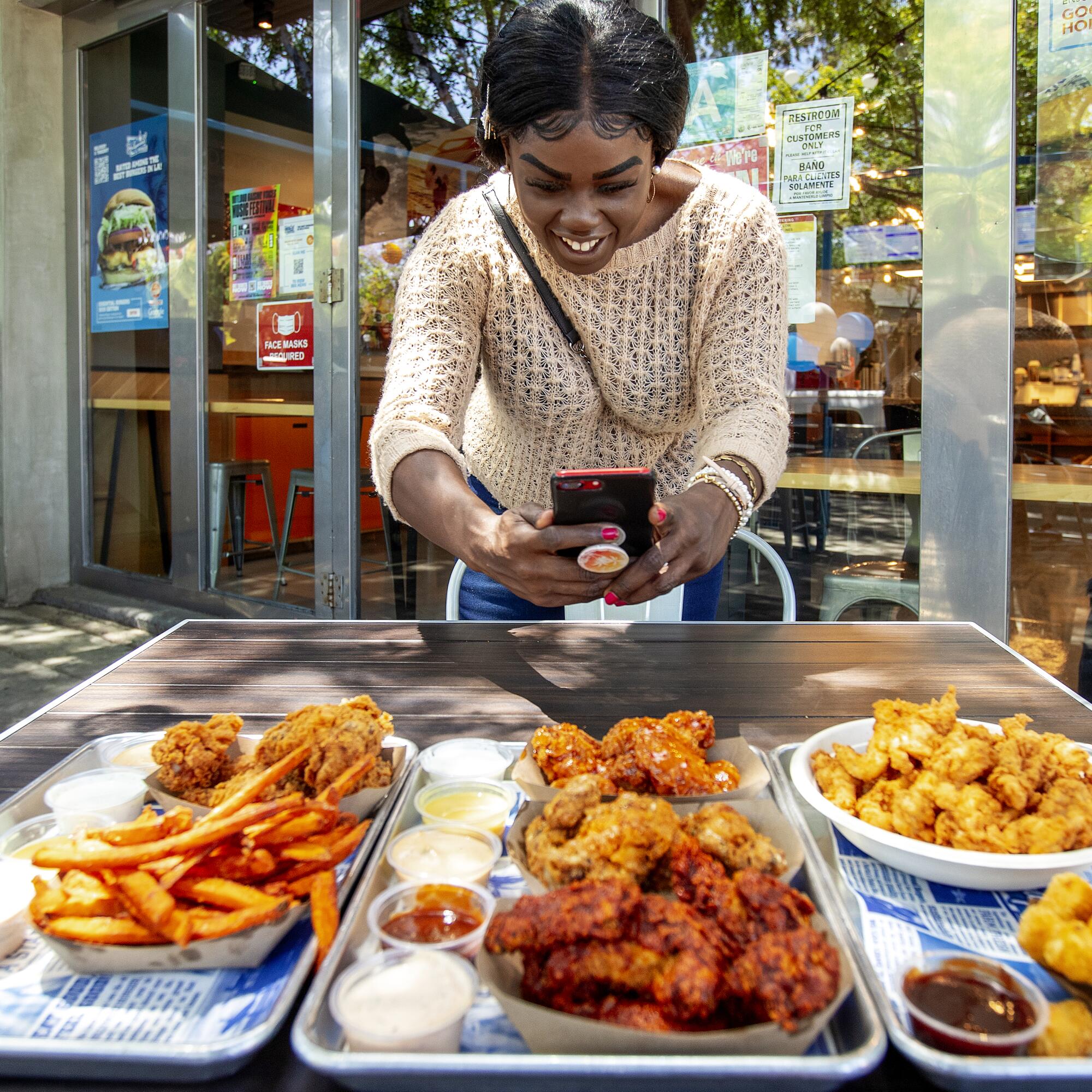
“If a restaurant says I need to disclose that something was free, then I’ll do it,” she says, “but if not, no, because when you put sponsored, paid, gifted, I noticed … my reach is lower.”
Do Ahaiwe and Rodriguez worry that accepting free meals might put them in a compromising position when it comes to posting about the restaurant? What if they don’t like the food?
Ahaiwe says she turns to another user-generated resource — Yelp reviews — to vet restaurants ahead of time.
“I never had an experience where I couldn’t find anything I liked, but I know eventually it will happen. I would have to apologize and just tell them that this is not going to work.”
We asked some of the city’s best chefs where they love to eat. Here’s a guide to their favorites, including pizza, sushi and Korean breakfast.
Rodriguez says she doesn’t do reviews. “I just educate people on what there is to order and try to highlight things.”
“This is Corona Mariscos in Van Nuys, California,” Rodriguez says in her voice-over on TikTok. “Trust me, aguachiles is way better than ceviche. ... Well, if you like spicy, that is. … Oh, did I mention this place has been around since 1999 and now run by two siblings? They’ve definitely kept up the quality of their father’s recipes.”

Though Rodriguez and Ahaiwe won’t knock a restaurant’s food, there are plenty of influencers who will. The hashtag #foodreview is connected to at least 1.6 million posts on Instagram and 13.4 billion on TikTok. Fear of upsetting influencers has created an unofficial code of silence among some traditional publicists and restaurant owners, who sometimes field dozens of requests from influencers for free food and restaurant tables.
“Restaurants operate on tiny margins,” Techamuanvivit says, “and we have payroll, insurance, all those things, and you’re asking us to fund your Instagram story content? It’s just not right.”
Last summer, a major-label musician with more than 1 million followers on Instagram reached out on that platform to Isaias Hernandez, chef-owner of Craft by Smoke and Fire. The celebrity — Hernandez won’t name him because he fears retaliation — asked if the Downey-based chef would be willing to supply food for 100 people at his home that evening. The celebrity told the restaurateur that he’d exchange a social media post or Instagram story for the food.
Hernandez and his partner cooked more than $400 worth of barbecue. They hand-delivered the food to the celebrity’s home, and even threw in some T-shirts in various sizes for guests. When he arrived, someone from the celebrity’s entourage took the food and the merch. Hernandez never met the celebrity or received a thank-you. There was no Instagram post.
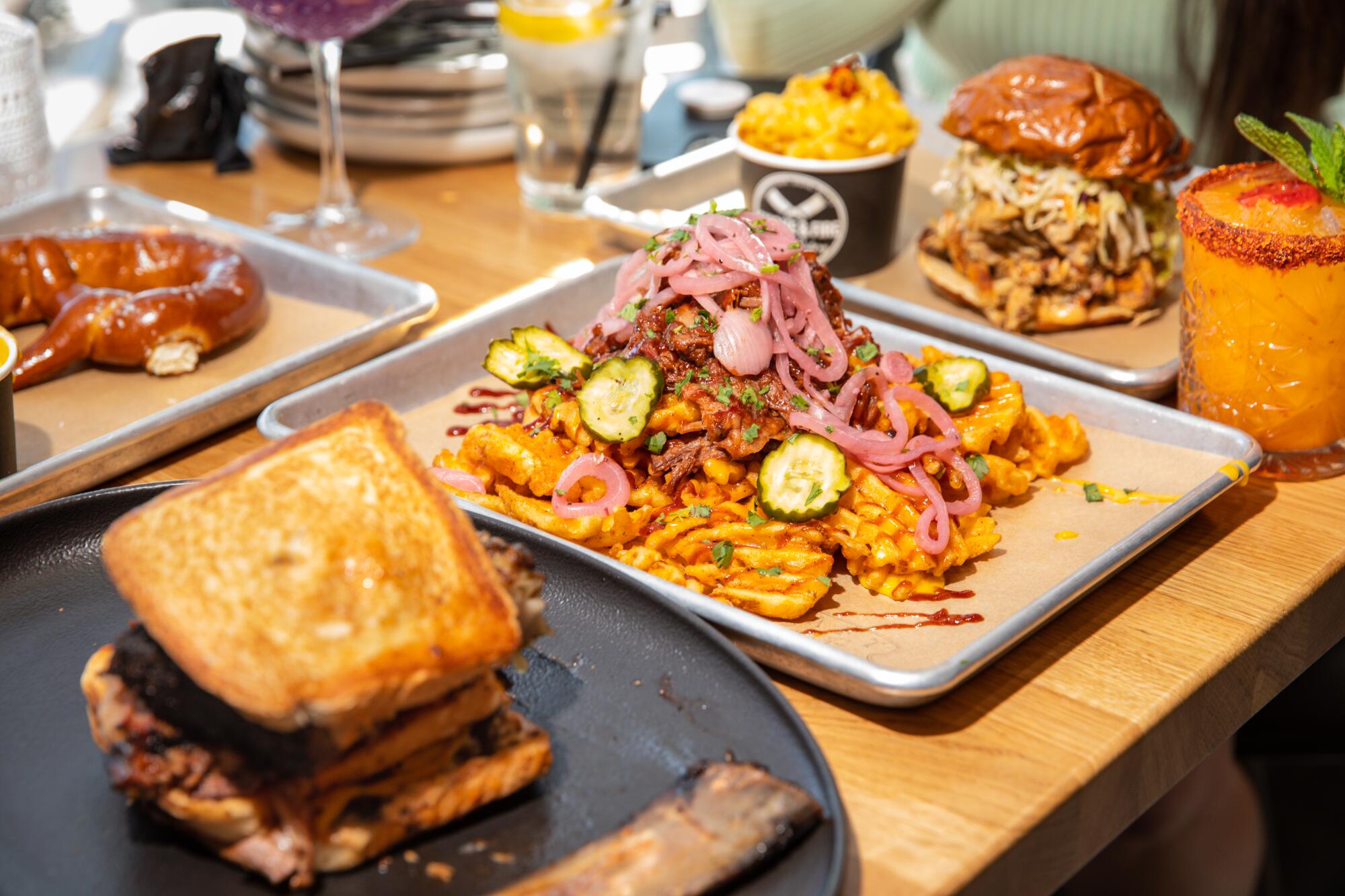
“I messaged him later asking if he liked the food, and he never responded,” Hernandez says. He decided to eat the cost and just keep quiet.
With multiple Michelin stars and a busy dining room, Techamuanvivit says, she’s in a position to speak up for the restaurants that can’t.
“I’m sure some of these influencers that we told to go away probably have written something bad on Yelp or Google reviews, but I don’t really care,” she says, adding, “I don’t fault the restaurants who work with them. People do what you have to do to survive.”
The power to make or break a restaurant once was reserved for the authoritative voice of the restaurant critic, a long-standing figure of traditional media; at many publications, taking freebies continues to be grounds for firing. (Los Angeles Times restaurant critic Bill Addison reviews anonymously and the newspaper pays for his meals.)
Here’s a guide on how to tell the difference between an L.A. Times journalist and a food influencer.
When Yelp was established almost two decades ago, it launched a new community-participant phase and expanded the opinion pool. Today’s food influencer further democratizes food media with posts that sometimes feel like the creators are sitting across the table from you.
Despite his experience, Hernandez, for the most part, is not only pro-food influencer, he’s built them into his restaurant’s marketing plans.
He’d hired Rodriguez, Castro and Harper in March 2020, as he was getting ready to open a restaurant in La Habra, Calif. The influencers strategize and host events for Hernandez’s restaurants, participate in quarterly meetings and provide feedback on everything, from the atmosphere to the food.
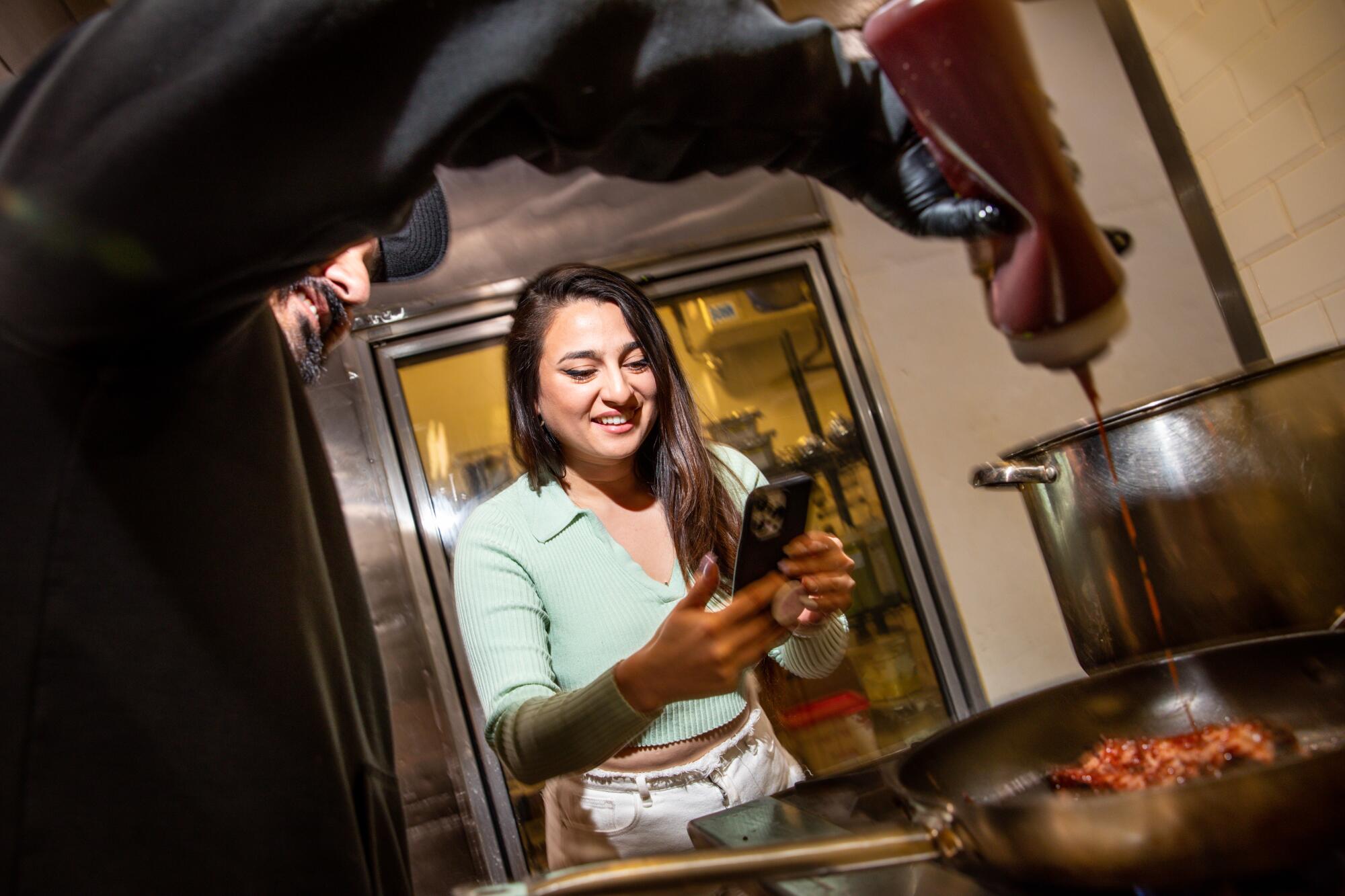
Hernandez’s grilled cheese sandwich now includes barbecue sauce because Harper thought it was too dry. Rodriguez’s suggestion for a bone-in short rib sandwich led to a 15% increase in sales the week that it was introduced.
“In general,” Hernandez says, “people perceive social influencers as snake-oil salesman of the past, but social media marketing is probably our strongest pillar in terms of sales growth.”
Kristin Diehl, a professor of marketing at USC Marshall School of Business, categorizes influencers as a part of marketing that falls under a larger communications umbrella.
Though she does recognize that influencers with larger followings can have a big impact on brands, she says it’s micro-influencers, people with around 10,000 to 50,000 followers and high engagement, who tend to have the most influence when it comes to restaurants.
“These micro-influencers are particularly effective and applicable to the restaurant industry, which is more localized,” she says.
Ahaiwe is a full-time micro-influencer with a full business plan and a media kit that explains her rates. She tailors her pitches to specific companies and says her rates have more to do with how much effort she’ll need to put in to make something look beautiful versus her number of followers.

“If I have to go out of my way to do a shoot, it can easily be $825. If the brand wants me in the photo smiling with the food,” she says, “that’s going to amp it up to $1,000 because now I have to find someone to be my plus-one to take photos.”
Ahaiwe travels with a car full of trays, silverware, changes of clothing and other props, ready to style food or other products for shoots. She schedules her social media posts months in advance.
On a recent afternoon, Ahaiwe visited Hollywood Burger in West Hollywood to take some photos and film some video. In addition to the milkshake and the burger she ordered, director of operations Kevin Shea brought out a tray full of chicken wings, a soon-to-be-released menu item he wanted to promote.
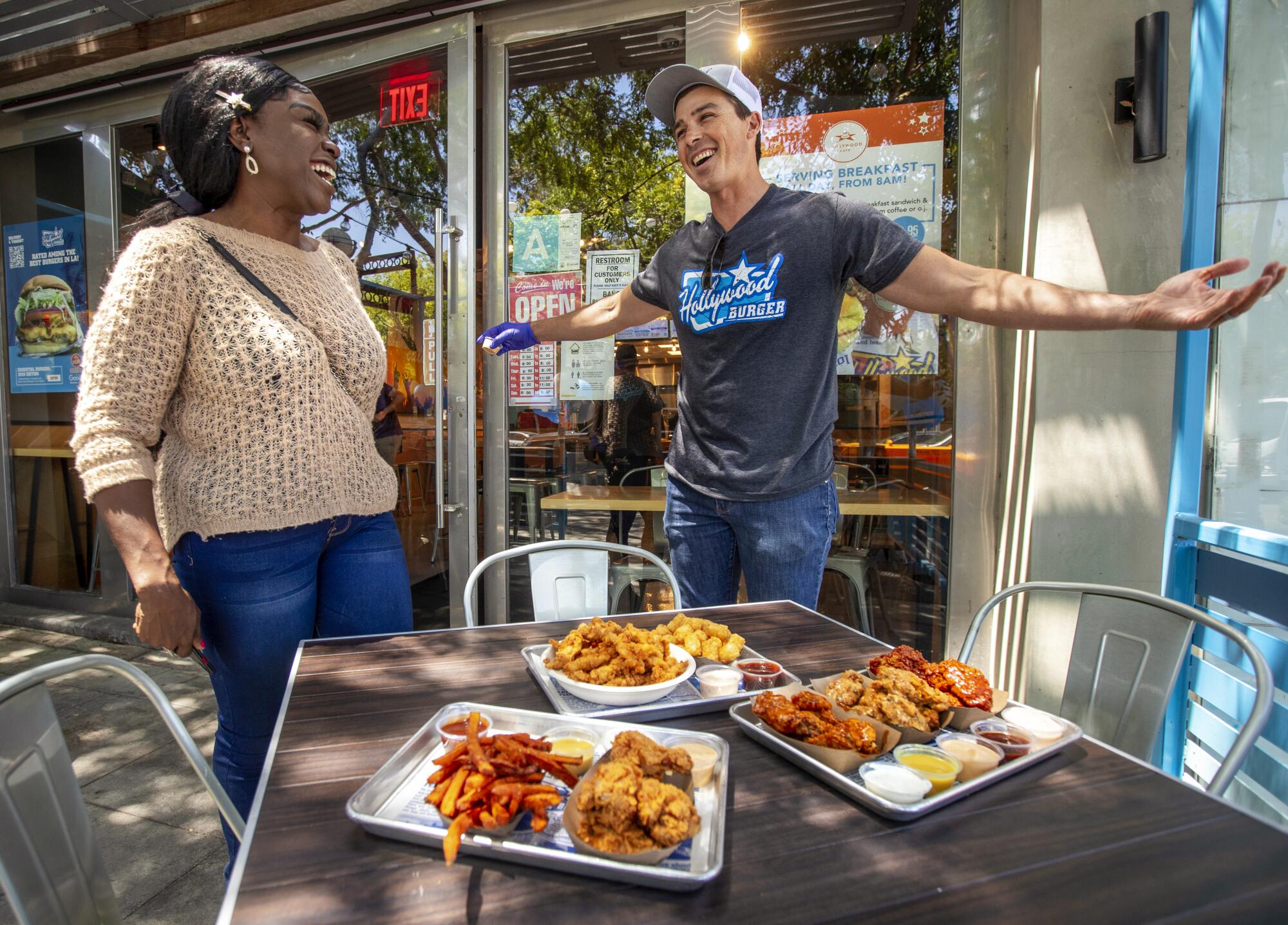
Ahaiwe, in turn, carefully styled her photos, arranging the wings in a row, dunking some into condiments and taking selfies with the chicken.
Shea said he expected to see an immediate boost in terms of followers and engagement for the restaurant when Ahaiwe eventually posts her photos on Instagram.
And she isn’t the only influencer Shea works with. “We have influencers DM-ing us like three to four times a week, saying, ‘Hey, can we “collab” and give us food,’ and we say no problem,” he says.
Hernandez estimates that $1 out of every $5 made at his restaurants goes to marketing, which includes the fee and free food given to influencers.
“I will never understand TikTok, but as a business owner you need to do your due diligence and find someone who does and bring them on board,” Hernandez says. “But social marketing is just a foot in the door; then you have to convince people to keep coming back.”
If you’re searching for the essential food of L.A., let our critic’s 2021 restaurant list be your guide! Find the best vegetarian, Japanese, Mexican cuisine and more.
- Share via
Watch L.A. Times Today at 7 p.m. on Spectrum News 1 on Channel 1 or live stream on the Spectrum News App. Palos Verdes Peninsula and Orange County viewers can watch on Cox Systems on channel 99.
More to Read
Eat your way across L.A.
Get our weekly Tasting Notes newsletter for reviews, news and more.
You may occasionally receive promotional content from the Los Angeles Times.
